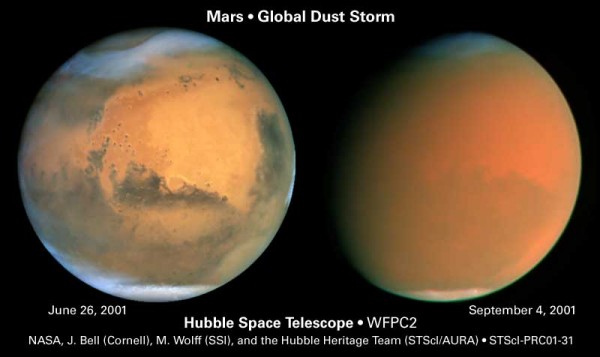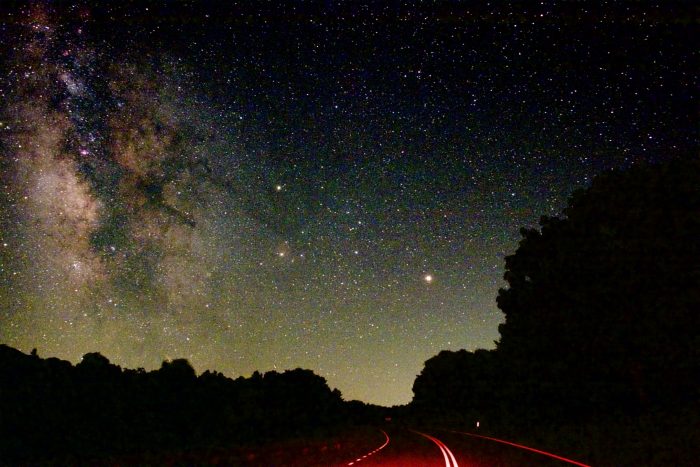
Southern spring and summer on the planet Mars have long been recognized as the dustiest part of Mars’ year. Now a new report adds details not previously described to the pattern of Mars’ seasonal dust storms, according to a June 9, 2016 statement from NASA. Over the past six Martian years, scientists have seen a pattern of three types of large regional dust storms occurring in sequence at about the same times each year, during Mars’ southern hemisphere spring and summer.
NASA said the clearest pattern in the storms has come to light via measurements of temperatures in the atmosphere of Mars. The temperature records come from NASA’s Mars orbiters, which have been operating continuously at Mars since 1997.
The Mars Reconnaissance Orbiter, for example, carries an instrument called a Mars Climate Sounder. David Kass of the Jet Propulsion Laboratory in Pasadena, California works with that instrument, and he’s lead author of a report about these findings posted by the journal Geophysical Research Letters. He commented in a statement:
When we look at the temperature structure instead of the visible dust, we finally see some regularity in the large dust storms.
The June 9 statement from NASA explained the relationship between the dust and Mars’ atmospheric temperatures. The dust absorbs sunlight, so the sun heats dusty air more than clear air, in some cases creating a difference of more than 63 degrees Fahrenheit (35 degrees Celsius) between dusty air and clear air.
This heating also affects the global wind distribution, which can produce downward motion that warms the air outside the dust-heated regions.

Most Martian dust storms are localized, NASA explained, smaller than about 1,200 miles (about 2,000 km) across and dissipating within a few days. Some become regional, affecting up to about a third of the planet and persisting up to three weeks. A few encircle Mars, covering the southern hemisphere but not the whole planet. Twice since 1997, global dust storms have fully enshrouded Mars, as in the Hubble image above.
The researchers identified three types of large regional storms – dubbed types A, B and C – all of which appeared in each of the six Martian years investigated (a Martian year lasts about two Earth-years). They explained that:
Multiple small storms form sequentially near Mars’ north pole in the northern autumn, similar to Earth’s cold-season Arctic storms that swing one after another across North America.
Kass said:
On Mars, some of these break off and head farther south along favored tracks. If they cross into [Mars’] southern hemisphere, where it is mid-spring, they get warmer and can explode into the much larger Type A dust storms.
When a Type A storm from Mars far north moves into southern-hemisphere spring, the sunlight on the dust warms the atmosphere. That energy boosts the speed of winds. The stronger winds lift more dust, further expanding the area and vertical reach of the storm.
In contrast, the Type B storm starts close to Mars’ south pole shortly before the beginning of southern summer. Its origin may be from winds generated at the edge of the retreating south-polar carbon dioxide ice cap. Multiple storms may contribute to a regional haze.
The Type C storm starts after the B storm ends. It originates in the north during northern winter (southern summer) and moves to the southern hemisphere like the Type A storm. From one year to another, the C storm varies more in strength, in terms of peak temperature and duration, than the A and B storms do.
Why study Mars’ dust storms? NASA said that improving the ability to predict large-scale, potentially hazardous dust storms on Mars would have safety benefits for planning robotic and human missions to the planet’s surface. Also, by recognizing patterns and categories of dust storms, researchers make progress toward understanding how seasonal local events affect global weather in a typical Mars year.
Read more about this study, and Mars dust storms, from JPL

Bottom line: A new report using temperature data from Mars orbiters adds details not previously described to the pattern of Mars’ seasonal dust storms.











